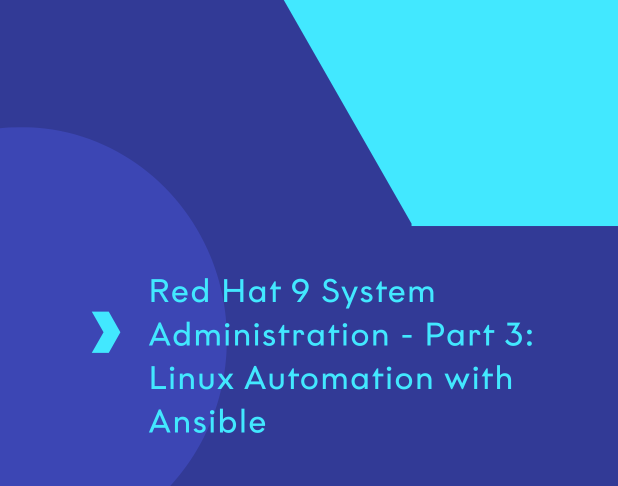Gain practical experience in a live lab environment using Ansible automation to manage remote systems, develop and optimise playbooks, roles, and tasks, and apply best practices. The content covered in this course will help you work towards RHCE (Red Hat Certified Engineer) certification and advanced system administration.
15% off eLearning, up to 20% off virtual courses - use code: EARLY1225NZ
Red Hat 8 System Administration - Part 3 - Linux Automation with Ansible
Select your learning method

Build practical automation skills for Red Hat systems
Learn how to streamline system tasks across Red Hat environments using Ansible. This practical course enhances your knowledge of automation principles, strengthens your technical insight, and builds the skills needed to design and apply reliable solutions, supporting both day-to-day operations and preparation for advanced certification.
- Understand how Ansible works
- Set up Ansible on both Debian and RHEL systems
- Run real-time Ansible commands via key modules
- Build and validate YAML files for automation
- Create and apply structured playbooks
- Use system tools to automate key admin tasks
- Enhance logic with variables, facts and checks
- Apply templates, roles and Galaxy components
- Secure automation with Vault and logging setups
- Use scripting and loops for efficient automation
What you’ll learn
Learn how automation enhances consistency and reduces manual effort. This hands-on ILX course equips you with techniques to build reliable automated systems.
Working with variables and facts
Learn how to define and manage variables using lists and dictionaries. You’ll discover how to load variables from files, pass them via the command line, and prompt for user input during playbook execution. We cover registering values from tasks, accessing Ansible facts, and using conditionals based on system information. Understand how to iterate through variables using loops and capture failures for more resilient automation. By combining these techniques, you’ll make your automation smarter and more adaptable to different environments and deployment contexts.
Templates and Ansible Galaxy
Understand how to create and use Jinja2 templates to dynamically generate configuration files based on variables and logic. You’ll construct file templates and learn how to use them within roles and playbooks. This section also guides you through searching, downloading and using shared roles and playbooks from Ansible Galaxy. You’ll develop the confidence to incorporate public content into your projects while maintaining best practices. Exercises cover real examples of templated configuration files to illustrate the flexibility and power of templating with Ansible.
Advanced configuration
Delve into advanced topics such as parallel execution, forks and connection strategies to increase efficiency. Learn to enable fact caching and understand its role in performance. Use Ansible Vault to encrypt sensitive information and manage secure access to confidential data. You’ll also configure server and client logging, manage output redirection and implement error-handling techniques including retries and ignore conditions. The section finishes by integrating Ansible into shell scripts, enabling you to trigger automation as part of wider workflows and processes.
- X days of instructor-led training in a live virtual classroom
- Interactive hands-on live labs
- All relevant course materials
Key facts
DevOps teams, Linux administrators and IT leads aiming to implement scalable RHEL automation.
Familiarity with Linux administration tasks as taught in Red Hat 8 – Part 2 or comparable experience.
Our experienced trainers and interactive labs create a focused, practical environment – so you can put theory into practice from day one.
FAQs
A hands-on Ansible training course covering full lifecycle automation of RHEL 8 system operations.
What is Ansible Vault and when would I use it?
Ansible Vault encrypts sensitive data such as passwords or keys. It ensures secure automation and protects confidential configurations.
Does this course teach error handling and logging in Ansible?
Yes. You’ll configure client/server logging, manage retries, ignore failed tasks and handle output redirection effectively.
What are Ansible modules and which ones are covered?
Modules are units of work in Ansible. The course covers key modules like copy, user, service, firewalld, SELinux, cron and more.
Can I automate system administration tasks with Ansible?
Absolutely. The course includes creating automation playbooks for tasks like user creation, firewall settings, file management and service control.
Is previous scripting experience required for this course?
While scripting knowledge is helpful, it’s not required. The course includes integration with shell scripts and guidance for beginners.
What our customers say

"Mark was an excellent tutor, making what can be a dry topic interesting and relevant to our business scenarios."

"Great course. Alan has been courteous and informative throughout. Highly recommended and will absolutely be coming back for more courses."
Join the half a million learners developing their skills with our training
A trusted partner to thousands of organisations worldwide
Our passionate team goes above and beyond to support customer needs
Please complete the form to ensure your quote is accurate and we will contact you soon.